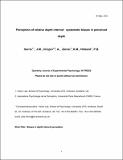Files in this item
Perception of relative depth interval : Systematic biases in perceived depth
Item metadata
| dc.contributor.author | Harris, Julie | |
| dc.contributor.author | Chopin, Adrien | |
| dc.contributor.author | Zeiner, Katharina Maria | |
| dc.contributor.author | Hibbard, Paul Barry | |
| dc.date.accessioned | 2012-06-12T14:31:02Z | |
| dc.date.available | 2012-06-12T14:31:02Z | |
| dc.date.issued | 2012 | |
| dc.identifier | 16281292 | |
| dc.identifier | ed53dba8-f578-4775-865a-ae13f283ad34 | |
| dc.identifier | 84859336897 | |
| dc.identifier.citation | Harris , J , Chopin , A , Zeiner , K M & Hibbard , P B 2012 , ' Perception of relative depth interval : Systematic biases in perceived depth ' , The Quarterly Journal of Experimental Psychology , vol. 65 , no. 1 , pp. 73-91 . https://doi.org/10.1080/17470218.2011.589520 | en |
| dc.identifier.issn | 1747-0218 | |
| dc.identifier.other | ORCID: /0000-0002-3497-4503/work/46085840 | |
| dc.identifier.uri | https://hdl.handle.net/10023/2749 | |
| dc.description.abstract | Given an estimate of the binocular disparity between a pair of points and an estimate of the viewing distance, or knowledge of eye position, it should be possible to obtain an estimate of their depth separation. Here we show that, when points are arranged in different vertical geometric configurations across two intervals, many observers find this task difficult. Those who can do the task tend to perceive the depth interval in one configuration as very different from depth in the other configuration. We explore two plausible explanations for this effect. The first is the tilt of the empirical vertical horopter: Points perceived along an apparently vertical line correspond to a physical line of points tilted backwards in space. Second, the eyes can rotate in response to a particular stimulus. Without compensation for this rotation, biases in depth perception would result. We measured cyclovergence indirectly, using a standard psychophysical task, while observers viewed our depth configuration. Biases predicted from error due either to cyclovergence or to the tilted vertical horopter were not consistent with the depth configuration results. Our data suggest that, even for the simplest scenes, we do not have ready access to metric depth from binocular disparity. | |
| dc.format.extent | 500728 | |
| dc.language.iso | eng | |
| dc.relation.ispartof | The Quarterly Journal of Experimental Psychology | en |
| dc.rights | This is a preprint of an article whose final and definitive form has been published in The Quarterly Journal of Experimental Psychology © 2012, copyright Taylor & Francis and The Experimental Psychology Society. The Quarterly Journal of Experimental Psychology is available online at http://dx.doi.org/10.1080/17470218.2011.589520 | en |
| dc.subject | Binocular disparity | en |
| dc.subject | Depth | en |
| dc.subject | Depth interval | en |
| dc.subject | Metric depth | en |
| dc.subject | Cyclovergence | en |
| dc.subject | Vertical horopter | en |
| dc.subject | BF Psychology | en |
| dc.subject.lcc | BF | en |
| dc.title | Perception of relative depth interval : Systematic biases in perceived depth | en |
| dc.type | Journal article | en |
| dc.contributor.sponsor | The Leverhulme Trust | en |
| dc.contributor.sponsor | EPSRC | en |
| dc.contributor.institution | University of St Andrews.School of Psychology and Neuroscience | en |
| dc.contributor.institution | University of St Andrews.Institute of Behavioural and Neural Sciences | en |
| dc.identifier.doi | 10.1080/17470218.2011.589520 | |
| dc.description.status | Peer reviewed | en |
| dc.identifier.grantnumber | RF-2011-019 | en |
| dc.identifier.grantnumber | EP/G038708/1 | en |
This item appears in the following Collection(s)
Items in the St Andrews Research Repository are protected by copyright, with all rights reserved, unless otherwise indicated.

